Back to Home Page / Back to Archive page
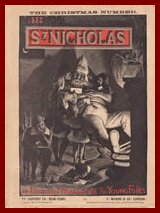
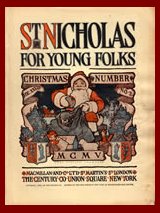

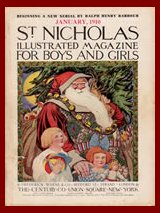
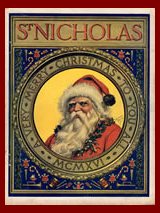
Magazine Covers featuring 'Santa Claus' from (l to r) 1882, 1905, 1906, 1910 and 1916
Who is St Nicholas?
(All articles reproduced from the Saint Nicholas Centre)
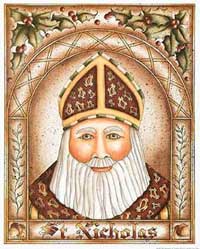 The true story of Santa Claus begins with Nicholas, who was born during the third century in the village of Patara. At the time the area was Greek and is now on the southern coast of Turkey. His wealthy parents, who raised him to be a devout Christian, died in an epidemic while Nicholas was still young. Obeying Jesus' words to "sell what you own and give the money to the poor," Nicholas used his whole inheritance to assist the needy, the sick, and the suffering. He dedicated his life to serving God and was made Bishop of Myra while still a young man. Bishop Nicholas became known throughout the land for his generosity to the those in need, his love for children, and his concern for sailors and ships.
The true story of Santa Claus begins with Nicholas, who was born during the third century in the village of Patara. At the time the area was Greek and is now on the southern coast of Turkey. His wealthy parents, who raised him to be a devout Christian, died in an epidemic while Nicholas was still young. Obeying Jesus' words to "sell what you own and give the money to the poor," Nicholas used his whole inheritance to assist the needy, the sick, and the suffering. He dedicated his life to serving God and was made Bishop of Myra while still a young man. Bishop Nicholas became known throughout the land for his generosity to the those in need, his love for children, and his concern for sailors and ships.
Under the Roman Emperor Diocletian, who ruthlessly persecuted Christians, Bishop Nicholas suffered for his faith, was exiled and imprisoned. The prisons were so full of bishops, priests, and deacons, there was no room for the real criminals—murderers, thieves and robbers. After his release, Nicholas attended the Council of Nicaea in AD 325. He died December 6, AD 343 in Myra and was buried in his cathedral church, where a unique relic, called manna, formed in his grave. This liquid substance, said to have healing powers, fostered the growth of devotion to Nicholas. The anniversary of his death became a day of celebration, St. Nicholas Day, December 6th (December 19 on the Julian Calendar).
St. Nicholas by Artist: Susan Seals
Through the centuries many stories and legends have been told of St. Nicholas' life and deeds. These accounts help us understand his extraordinary character and why he is so beloved and revered as protector and helper of those in need.
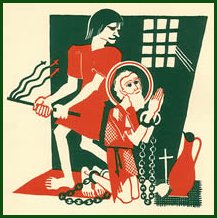
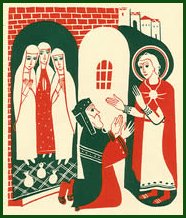
St. Nicholas in prison by Artist: Elisabeth Jvanovsky / St. Nicholas giving dowry gold by Artist: Elisabeth Jvanovsky
One story tells of a poor man with three daughters. In those days a young woman's father had to offer prospective husbands something of value—a dowry. The larger the dowry, the better the chance that a young woman would find a good husband. Without a dowry, a woman was unlikely to marry. This poor man's daughters, without dowries, were therefore destined to be sold into slavery. Mysteriously, on three different occasions, a bag of gold appeared in their home-providing the needed dowries. The bags of gold, tossed through an open window, are said to have landed in stockings or shoes left before the fire to dry. This led to the custom of children hanging stockings or putting out shoes, eagerly awaiting gifts from Saint Nicholas. Sometimes the story is told with gold balls instead of bags of gold. That is why three gold balls, sometimes represented as oranges, are one of the symbols for St. Nicholas. And so St. Nicholas is a gift-giver.
One of the oldest stories showing St. Nicholas as a protector of children takes place long after his death. The townspeople of Myra were celebrating the good saint on the eve of his feast day when a band of Arab pirates from Crete came into the district. They stole treasures from the Church of Saint Nicholas to take away as booty. As they were leaving town, they snatched a young boy, Basilios, to make into a slave. The emir, or ruler, selected Basilios to be his personal cupbearer, as not knowing the language, Basilios would not understand what the king said to those around him. So, for the next year Basilios waited on the king, bringing his wine in a beautiful golden cup. For Basilios' parents, devastated at the loss of their only child, the year passed slowly, filled with grief. As the next St. Nicholas' feast day approached, Basilios' mother would not join in the festivity, as it was now a day of tragedy. However, she was persuaded to have a simple observance at home—with quiet prayers for Basilios' safekeeping. Meanwhile, as Basilios was fulfilling his tasks serving the emir, he was suddenly whisked up and away. St. Nicholas appeared to the terrified boy, blessed him, and set him down at his home back in Myra. Imagine the joy and wonderment when Basilios amazingly appeared before his parents, still holding the king's golden cup. This is the first story told of St. Nicholas protecting children—which became his primary role in the West.
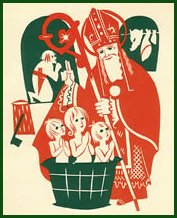
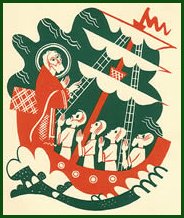
St. Nicholas rescuing murdered children by Artist: Elisabeth Jvanovsky / St. Nicholas' prayer calming seas by Artist: Elisabeth Jvanovsky
Another story tells of three theological students, travelling on their way to study in Athens. A wicked innkeeper robbed and murdered them, hiding their remains in a large pickling tub. It so happened that Bishop Nicholas, travelling along the same route, stopped at this very inn. In the night he dreamed of the crime, got up, and summoned the innkeeper. As Nicholas prayed earnestly to God the three boys were restored to life and wholeness. In France the story is told of three small children, wandering in their play until lost, lured, and captured by an evil butcher. St. Nicholas appears and appeals to God to return them to life and to their families. And so St. Nicholas is the patron and protector of children.
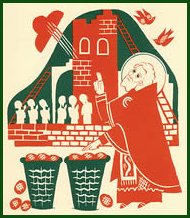
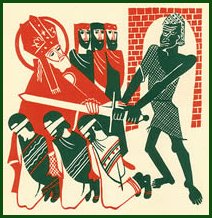
St. Nicholas providing food during famine by Artist: Elisabeth Jvanovsky / St. Nicholas saving innocents by Artist: Elisabeth Jvanovsky
Several stories tell of Nicholas and the sea. When he was young, Nicholas sought the holy by making a pilgrimage to the Holy Land. There as he walked where Jesus walked, he sought to more deeply experience Jesus' life, passion, and resurrection. Returning by sea, a mighty storm threatened to wreck the ship. Nicholas calmly prayed. The terrified sailors were amazed when the wind and waves suddenly calmed, sparing them all. And so St. Nicholas is the patron of sailors and voyagers.
Other stories tell of Nicholas saving his people from famine, sparing the lives of those innocently accused, and much more. He did many kind and generous deeds in secret, expecting nothing in return. Within a century of his death he was celebrated as a saint. Today he is venerated in the East as wonder, or miracle worker and in the West as patron of a great variety of persons-children, mariners, bankers, pawn-brokers, scholars, orphans, labourers, travellers, merchants, judges, paupers, marriageable maidens, students, children, sailors, victims of judicial mistakes, captives, perfumers, even thieves and murderers! He is known as the friend and protector of all in trouble or need.
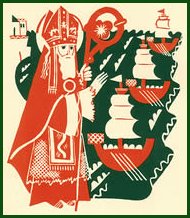

St. Nicholas blessing ships by Artist: Elisabeth Jvanovsky / St. Nicholas by Artist: Elisabeth Jvanovsky
Sailors, claiming St. Nicholas as patron, carried stories of his favour and protection far and wide. St. Nicholas chapels were built in many seaports. As his popularity spread during the Middle Ages, he became the patron saint of Apulia (Italy), Sicily, Greece, and Lorraine (France), and many cities in Germany, Austria, Switzerland, Italy, Russia, Belgium, and the Netherlands. Following his baptism in Constantinople, Vladimir I of Russia brought St. Nicholas' stories and devotion to St. Nicholas to his homeland where Nicholas became the most beloved saint. Nicholas was so widely revered that more than 2,000 churches were named for him, including three hundred in Belgium, thirty-four in Rome, twenty-three in the Netherlands and more than four hundred in England.
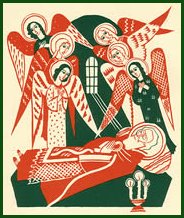
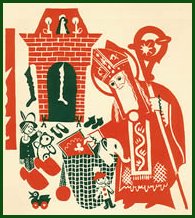
St. Nicholas death by Artist: Elisabeth Jvanovsky / St. Nicholas bringing gifts by Artist: Elisabeth Jvanovsky
Nicholas' tomb in Myra became a popular place of pilgrimage. Because of the many wars and attacks in the region, some Christians were concerned that access to the tomb might become difficult. For both the religious and commercial advantages of a major pilgrimage site, the Italian cities of Venice and Bari vied to get the Nicholas relics. In the spring of 1087, sailors from Bari succeeded in spiriting away the bones, bringing them to Bari, a seaport on the southeast coast of Italy. An impressive church was built over St. Nicholas' crypt and many faithful journeyed to honour the saint who had rescued children, prisoners, sailors, famine victims, and many others through his compassion, generosity, and the countless miracles attributed to his intercession. The Nicholas shrine in Bari was one of medieval Europe's great pilgrimage centres and Nicholas became known as "Saint in Bari." To this day pilgrims and tourists visit Bari's great Basilica di San Nicola.
Through the centuries St. Nicholas has continued to be venerated by Catholics and Orthodox and honoured by Protestants. By his example of generosity to those in need, especially children, St. Nicholas continues to be a model for the compassionate life.
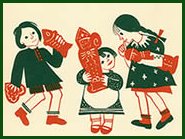

Celebrating St. Nicholas by Artist: Elisabeth Jvanovsky
Widely celebrated in Europe, St. Nicholas' feast day, December 6th, kept alive the stories of his goodness and generosity. In Germany and Poland, boys dressed as bishops begged alms for the poor—and sometimes for themselves! In the Netherlands and Belgium, St. Nicholas arrived on a steamship from Spain to ride a white horse on his gift-giving rounds. December 6th is still the main day for gift giving and merrymaking in much of Europe. For example, in the Netherlands St. Nicholas is celebrated on the 5th, the eve of the day, by sharing candies (thrown in the door), chocolate initial letters, small gifts, and riddles. Dutch children leave carrots and hay in their shoes for the saint's horse, hoping St. Nicholas will exchange them for small gifts. Simple gift-giving in early Advent helps preserve a Christmas Day focus on the Christ Child.
Saint Nicholas and the Origins of Santa Claus
 How did the kindly Christian saint, good Bishop Nicholas, become a roly-poly red-suited American symbol for merry holiday festivity and commercial activity? History tells the tale.
How did the kindly Christian saint, good Bishop Nicholas, become a roly-poly red-suited American symbol for merry holiday festivity and commercial activity? History tells the tale.
The first Europeans to arrive in the New World brought St. Nicholas. Vikings dedicated their cathedral to him in Greenland. On his first voyage, Columbus named a Haitian port for St. Nicholas on December 6, 1492. In Florida, Spaniards named an early settlement St. Nicholas Ferry, now known as Jacksonville.
Bishop St. Nicholas, early American St. Nick, & American Santa, from Santa Claus Comes to America, by Caroline Singer & Cyrus Baldridge, Alfred Knopf, 1942
However, St. Nicholas had a difficult time during the 16th century Protestant Reformation which took a dim 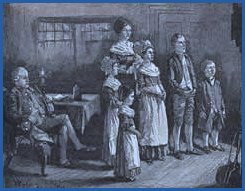 view of saints. Even though both reformers and counter-reformers tried to stamp out St. Nicholas-related customs, they had very little long-term success except in England where the religious folk traditions were permanently altered. (It is ironic that fervent Puritan Christians began what turned into a trend to a more secular Christmas observance.) Because the common people so loved St. Nicholas, he survived on the European continent as people continued to place nuts, apples, and sweets in shoes left beside beds, on windowsills, or before the hearth.
view of saints. Even though both reformers and counter-reformers tried to stamp out St. Nicholas-related customs, they had very little long-term success except in England where the religious folk traditions were permanently altered. (It is ironic that fervent Puritan Christians began what turned into a trend to a more secular Christmas observance.) Because the common people so loved St. Nicholas, he survived on the European continent as people continued to place nuts, apples, and sweets in shoes left beside beds, on windowsills, or before the hearth.
The first Colonists, primarily Puritans and other Protestant reformers, did not bring Nicholas traditions to the New World. What about the Dutch? Although it is almost universally believed that the Dutch brought St. Nicholas to New Amsterdam, scholars find scant evidence of such traditions in Dutch New Netherlands. Colonial Germans in Pennsylvania kept the feast of St. Nicholas, and several later
"New Year's Hymn to St. Nicholas," colonial Dutch life, Albany, NY. Harper's New Monthly Magazine, March 1881 - St. Nicholas Centre Collection
accounts have St. Nicholas visiting New York Dutch on New Years' Eve (New Year gift-giving had become the English custom in 1558, supplanting Nicholas, and this English custom was still found in New York until 1847).
In 1773 New York non-Dutch patriots formed the Sons of St. Nicholas, primarily as a non-British symbol to counter the English St. George societies, rather than to honour St. Nicholas. This society was similar to the Sons of St. Tammany in Philadelphia. Not exactly St. Nicholas, the children's gift-giver.
 After the American Revolution, New Yorkers remembered with pride their colony's nearly-forgotten Dutch roots. John Pintard, the influential patriot and antiquarian who founded the New York Historical Society in 1804, promoted St. Nicholas as patron saint of both society and city. In January 1809, Washington Irving joined the society and on St. Nicholas Day that same year, he published the satirical fiction, Knickerbocker's History of New York, with numerous references to a jolly St. Nicholas character. This was not the saintly bishop, rather an elfin Dutch burgher with a clay pipe. These delightful flights of imagination are the source of the New Amsterdam St. Nicholas legends: that the first Dutch emigrant ship had a figurehead of St. Nicholas: that St. Nicholas Day was observed in the colony; that the first church was dedicated to him; and that St. Nicholas comes down chimneys to bring gifts. Irving's work was regarded as the "first notable work of imagination in the New World."
After the American Revolution, New Yorkers remembered with pride their colony's nearly-forgotten Dutch roots. John Pintard, the influential patriot and antiquarian who founded the New York Historical Society in 1804, promoted St. Nicholas as patron saint of both society and city. In January 1809, Washington Irving joined the society and on St. Nicholas Day that same year, he published the satirical fiction, Knickerbocker's History of New York, with numerous references to a jolly St. Nicholas character. This was not the saintly bishop, rather an elfin Dutch burgher with a clay pipe. These delightful flights of imagination are the source of the New Amsterdam St. Nicholas legends: that the first Dutch emigrant ship had a figurehead of St. Nicholas: that St. Nicholas Day was observed in the colony; that the first church was dedicated to him; and that St. Nicholas comes down chimneys to bring gifts. Irving's work was regarded as the "first notable work of imagination in the New World."
The New York Historical Society held its first St. Nicholas anniversary dinner on December 6, 1810. John Pintard commissioned artist Alexander Anderson to create the first American image of Nicholas for the occasion. Nicholas was shown in a gift-giving role with children's treats in stockings hanging at a fireplace. The accompanying poem ends, "Saint Nicholas, my dear good friend! To serve you ever was my end, If you will, now, me something give, I'll serve you ever while I live."
The 19th century was a time of cultural transition. New York writers, and others, wanted to domesticate the Christmas holiday. Christmas of old was not images of families gathered cosily around hearth and tree exchanging pretty gifts and singing carols while smiling benevolently at children. Rather, it was characterized by raucous, drunken mobs
Detail from broadside by Alexander Anderson, December 6, 1810 - St Nicholas Centre Collection
roaming streets, damaging property, threatening and frightening the upper classes. The holiday season, coming after harvest when work was 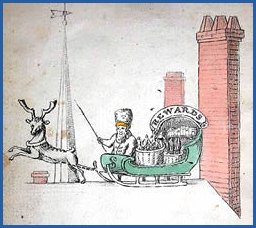 eased and more leisure possible, was a time when workers and servants took the upper hand, demanding largess and more. At the same time a new understanding of family life and the place of children was also emerging. Childhood was coming to be seen as a stage of life in which greater protection, sheltering, training and education were needed. And so the season came to be tamed, turning toward shops and home. St. Nicholas, too, took on new attributes to fit the changing times.
eased and more leisure possible, was a time when workers and servants took the upper hand, demanding largess and more. At the same time a new understanding of family life and the place of children was also emerging. Childhood was coming to be seen as a stage of life in which greater protection, sheltering, training and education were needed. And so the season came to be tamed, turning toward shops and home. St. Nicholas, too, took on new attributes to fit the changing times.
1821 brought some new elements with publication of the first lithographed book in America, the Children's Friend. This "Santa Claus" arrived from the North in a sleigh with a flying reindeer. The anonymous poem and illustrations proved pivotal in shifting imagery away from a saintly bishop. Santa Claus fit a didactic mode, rewarding good behaviour and punishing bad, leaving a "long, black birchen rod . . . directs a Parent's hand to use when virtue's path his sons refuse." Gifts were safe toys, "pretty doll . . . peg-top, or a ball; no crackers, cannons, squibs, or rockets to blow their eyes up, or their pockets. No drums to stun their Mother's ear, nor swords to make their sisters fear; but pretty books to store their mind with knowledge of each various kind." The sleigh itself even sported a bookshelf for the "pretty books." The book also notably marked S. Claus' first appearance on Christmas Eve, rather than December 6th.
Santa Claus - The Children's Friend, 1821
The jolly elf image received another big boost in 1823, from a poem destined to become immensely popular, "A Visit from St. Nicholas," now better known as "The Night Before Christmas."
He was dressed all in fur, from his head to his foot,
And his clothes were all tarnished with ashes and soot;
A bundle of toys he had flung on his back,
And he looked like a peddler just opening his pack.
His eyes—how they twinkled! his dimples how merry!
His cheeks were like roses, his nose like a cherry!
His droll little mouth was drawn up like a bow,
And the beard of his chin was as white as the snow;
The stump of a pipe he held tight in his teeth,
And the smoke it encircled his head like a wreath;
He had a broad face and a little round belly,
That shook, when he laughed like a bowlful of jelly.
He was chubby and plump, a right jolly old elf. . . .
Washington Irving's St. Nicholas strongly influenced the poem's portrayal of a round, pipe-smoking, elf-like St. Nicholas. The poem generally has been attributed to Clement Clark Moore, a professor of biblical languages at New York's Episcopal General Theological Seminary. However, a case has been made by Don Foster in Author Unknown, that Henry Livingston actually penned it in 1807 or 1808. Livingston was a farmer/patriot who wrote humorous verse for children. In any case, "A Visit from St. Nicholas" became a defining American holiday classic. No matter who wrote it, the poem has had enormous influence on the Americanization of St. Nicholas.
Other artists and writers continued the change to an elf-like St. Nicholas, "Sancte Claus," or "Santa Claus," unlike the stately European bishop. In 1863, during the Civil War, political cartoonist Thomas Nast began a series of annual black-and-white drawings in Harper's Weekly, based on the descriptions found in the poem and Washington Irving's work. These drawings established a rotund Santa with flowing beard, fur garments, and an omnipresent clay pipe. Nast's Santa supported the Union and President Lincoln believed this contributed to the Union troops' success by demoralizing Confederate soldiers. As Nast drew Santas until 1886, his work had considerable influence in forming the American Santa Claus. Along with appearance changes, the saint's name shifted to Santa Claus—a natural phonetic alteration from the German Sankt Niklaus.
Santa was then portrayed by dozens of artists in a wide variety of styles, sizes, and colours. However by the end of the 1920s, a standard American Santa—life-sized in a red, fur-trimmed suit—had emerged from the work of N. C. Wyeth, Norman Rockwell and other popular illustrators. In 1931 Haddon Sundblom began thirty-five years of Coca-Cola Santa advertisements that popularized and firmly established this Santa as an icon of contemporary commercial culture.
This Santa was life-sized, jolly, and wore the now familiar red suit. He appeared in magazines, on billboards, and shop counters, encouraging Americans to see Coke as the solution to "a thirst for all seasons." By the 1950s Santa was turning up everywhere as a benign source of beneficence, endorsing an amazing range of consumer products. This commercial success led to the North American Santa Claus being exported around the world where he threatens to overcome the European St. Nicholas, who has retained his identity as a Christian bishop and saint.
It's been a long journey from the Fourth Century Bishop of Myra, St. Nicholas, who showed his devotion to God in extraordinary kindness and generosity to those in need, to America's jolly Santa Claus, whose largesse often supplies luxuries to the affluent. However, if you peel back the accretions, he is still Nicholas, Bishop of Myra, whose caring surprises continue to model true giving and faithfulness.
There is growing interest in reclaiming the original saint in the United States to help restore a spiritual dimension to this festive time. For indeed, St. Nicholas, lover of the poor and patron saint of children, is a model of how Christians are meant to live. A bishop, Nicholas put Jesus Christ at the centre of his life, his ministry, his entire existence. Families, churches, and schools are embracing true St Nicholas traditions as one way to claim the true centre of Christmas—the birth of Jesus. Such a focus helps restore balance to increasingly materialistic and stress-filled Advent and Christmas seasons.
Nast Santa, Bishop Nicholas, Coke Santa, illustration by Renee Graef, A Special Place for Santa Roman, Inc., 1991. Permission pending.
Was Saint Nicholas a Real Person?
Some say St. Nicholas existed only in legend, without any reliable historical record. Legends usually do grow out of real, actual events, though they may be embellished to make more interesting stories. Many of the St. Nicholas stories seem to be truth interwoven with imagination. However, the following facts of the life of St. Nicholas could contain some part of historical truth. They provide a clear sense of his personal characteristics which are further elaborated in other narratives.
• Nicholas' birth in Patara
Though the exact date is not known, it is believed to have occurred between AD 260 and 280. The place, Patara, can be historically grounded.
• Dowries for the poor girls
This story, distinct to Nicholas, can be regarded as historical in its essence. There are three very ancient accounts which only differ in regard to the number of maidens and other detail. This event reveals important aspects of St. Nicholas's personality, namely, his charitable nature and humility. This story is not found in hagiographic accounts of other saints' lives.
• Election as Bishop of Myra, though not yet a priest
Unusual though it was for a non-ordained person to be nominated to the position of bishop, two sources
Card from St Nicholas Church, North Walsham, Norfolk, UK St. Nicholas Centre Collection
corroborate the story. Because it is so unusual, there are only two other such known cases (Saint Severus and Saint Ambrose), it adds credence to the story as it is not something that would be made up.
• Participation in the Council of Nicaea
Although Bishop Nicholas does not appear on all lists of attenders, his name appears on the oldest Greek list and on five other lists.
• Saving three condemned innocents
This story is the oldest and most genuine recorded episode from the life of St. Nicholas. Historical documentation confirms the many references to place names and people. Some versions expand the account to include the story of the three generals.
• Intervention in favour of the unjustly jailed
The outstanding figures in this solidly structured story are well known in other contemporary accounts, where they are portrayed in similar ways.
• Destruction of the Temple of Artemis
This account reveals knowledge of detail concerning the temple which would have been unknown to a writer several centuries later had it not been based on an account coming out of the people and traditions of that city.
• Mariners saved during a tempest
The episode is important to explain the origin of his wide-spread patronage to sailors and other sea voyagers.
The earliest reference to St. Nicholas of Myra comes from the late 700s—about 250 years after his death. The life of St. Nicholas of Sion (a 6th century abbot of a mountain monastery near Myra) describes a visit "going down to the metropolis of Myra, [Nicholas of Sion] went off to the martyrium of the glorious Saint Nicholas." This reliable witness, written by a close associate of Nicholas of Sion shortly after his death, roots Nicholas of Myra in history and reveals his status as a revered saint.
The ancient sources cited to substantiate this information are Michael the Archimandrite, Sinaitic and Ethiopian manuscripts, Gratianus' Decretum, Theodore the Lector, Andrew of Crete, Eustratios of Constantinople, AD 583; Passionarium Romanum, 650 AD; and Praxis de tributo.
The Real Face of Saint Nicholas
Have you ever wondered what St. Nicholas really looked like?
If so, you aren't the only one!
How does this modern forensic reconstruction of Saint Nicholas' face compare with traditional images developed and handed down by iconographers through the centuries?
What do you think?
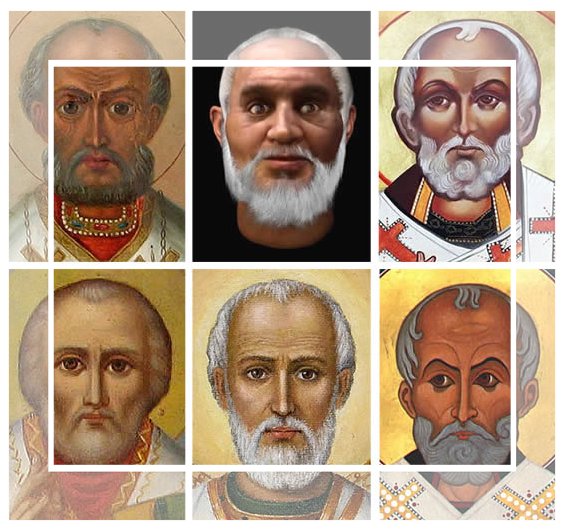
Top row: Russian icon, circa 1900; Forensic reconstruction/Anand Kapoor, 2004, used by permission; Russian icon, 2001
Bottom row: 19th century Russian icon; Russian painting, circa 1990; USA icon, 2000 (Jack Pachuta)
Icons from the St Nicholas Center Collection
Modern forensic anthropology has developed tools to help discover what people looked like. These techniques are primarily used to assist in identifying unknown crime victims. However, they can be used also for historic personages when there is access to the right information. Normally, this would be skeletal remains, including the skull.
St. Nicholas' remains are buried in the crypt of the Basilica di San Nicola in Bari, Italy. These bones were temporarily removed when the crypt was repaired during the 1950s. At the Vatican's request, anatomy professor Luigi Martino from the University of Bari, took thousands of minutely-detailed measurements and x-ray photographs (roentgenography) of the skull and other bones.
The current professor of forensic pathology at the University of Bari, Francesco Introna, knew advancements in diagnostic technique could yield much more from the data gathered in the 1950s. So he engaged an expert facial anthropologist, Caroline Wilkinson, at the University of Manchester in England, to construct a model of the saint's head from the earlier measurements.
Using this data, the medical artist used state-of-the-art computer software to develop the model of St. Nicholas. The virtual clay was sculpted on screen using a special tool that allows one to "feel" the clay as it is moulded. Dr. Wilkinson says, "In theory you could do the same thing with real clay, but it's much easier, far less time-consuming and more reliable to do it on a computer."
After inferring the size and shape of facial muscles—there are around twenty-six—from the skull data, the muscles are pinned onto the virtual skull, stretched into position, and covered with a layer of "skin." "The muscles connect in the same place on everyone, but because skulls vary in shape, a different face develops," Wilkinson comments. The tangents from different parts of the nasal cavity determine the length of a nose. This was difficult because St. Nicholas' nose had been badly broken. "It must have been a very hefty blow because it's the nasal bones between the eyes that are broken," she continued. "We used clay on the screen that you can feel but not physically touch. It was very exciting. We did not have the physical skull, so we had to recreate it from two-dimensional data. We are bound to have lost some of the level of detail you would get by working from photographs, but we believe this is the closest we are ever going to get to him," Wilkinson concluded.
Next the three-dimensional image went to Image Foundry Studios where a digital artist added detail and colour to the model. This gave it Greek Mediterranean olive-toned skin, brown eyes, and grey hair and beard, trimmed in 4th century fashion.
The result of the project is the image of a Greek man, living in Asia Minor (part of the Greek Byzantine Empire), about 60-years old, 5-feet 6-inches tall, who had a heavy jaw and a broken nose.
Press reaction to the facsimile tended to imply that good Saint Nicholas had had a brawling past, hence the broken nose. It is more likely, however, that his nose was broken when imprisoned and tortured during the persecution of Christians under Roman Emperor Diocletian.
The image and the process to create it were featured on a one-hour television documentary, The Real Face of Santa, produced by Atlantic Productions for BBC 2 and also shown on the Discovery Channel.
Image Source: Image Foundry Studios
A Visit from St. Nicholas - a poem by Clement Clarke Moore
'Twas the night before Christmas, when all through the house
Not a creature was stirring, not even a mouse;
The stockings were hung by the chimney with care,
In hopes that St. Nicholas soon would be there;
The children were nestled all snug in their beds;
While visions of sugar-plums danced in their heads;
And mamma in her 'kerchief, and I in my cap,
Had just settled our brains for a long winter's nap,
When out on the lawn there arose such a clatter,
I sprang from my bed to see what was the matter.
Away to the window I flew like a flash,
Tore open the shutters and threw up the sash.
The moon on the breast of the new-fallen snow,
Gave a lustre of midday to objects below,
When what to my wondering eyes did appear,
But a miniature sleigh and eight tiny rein-deer,
With a little old driver so lively and quick,
I knew in a moment he must be St. Nick.
More rapid than eagles his coursers they came,
And he whistled, and shouted, and called them by name:
"Now, Dasher! now, Dancer! now Prancer and Vixen!
On, Comet! on, Cupid! on, Donner and Blitzen!
To the top of the porch! to the top of the wall!
Now dash away! dash away! dash away all!"
As leaves that before the wild hurricane fly,
When they meet with an obstacle, mount to the sky;
So up to the housetop the coursers they flew
With the sleigh full of toys, and St. Nicholas too—
And then, in a twinkling, I heard on the roof
The prancing and pawing of each little hoof.
As I drew in my head, and was turning around,
Down the chimney St. Nicholas came with a bound.
He was dressed all in fur, from his head to his foot,
And his clothes were all tarnished with ashes and soot;
A bundle of toys he had flung on his back,
And he looked like a pedler just opening his pack.
His eyes—how they twinkled! his dimples, how merry!
His cheeks were like roses, his nose like a cherry!
His droll little mouth was drawn up like a bow,
And the beard on his chin was as white as the snow;
The stump of a pipe he held tight in his teeth,
And the smoke, it encircled his head like a wreath;
He had a broad face and a little round belly
That shook when he laughed, like a bowl full of jelly.
He was chubby and plump, a right jolly old elf,
And I laughed when I saw him, in spite of myself;
A wink of his eye and a twist of his head
Soon gave me to know I had nothing to dread;
He spoke not a word, but went straight to his work,
And filled all the stockings; then turned with a jerk,
And laying his finger aside of his nose,
And giving a nod, up the chimney he rose;
He sprang to his sleigh, to his team gave a whistle,
And away they all flew like the down of a thistle.
But I heard him exclaim, ere he drove out of sight—
Happy Christmas to all, and to all a good night!”
With thanks to the Poetry Foundation and Random House for the poem written circa 1822
Page refreshed : 20th December 2017 (G)